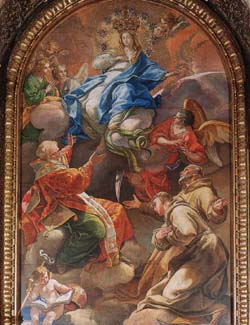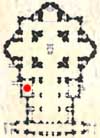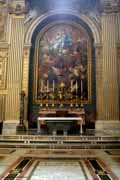| Grottoes
Vatican City Colonnade Saints Floorplan #2 |
| Altars
Monuments The History |
| Related
Items Chapel of the Choir |

|
The mosaic
of the Virgin Immaculate was crowned by Pius IX for the Definition
of Mary's Immaculate Conception. A crown of diamonds was added in 1904.
|
From: 'St. Peter's - Guide to the Basilica and Square'
The
altarpiece, by Pietro Bianchi (1694-1740), shows the Virgin Immaculate
in glory surrounded by angels and venerated by Sts. Francis of Assisi,
Anthony of Padua, John Chrysostom. On December 8, 1854, on the occasion
of the proclamation of the Dogma of the Immaculate Conception, Pius IX
crowned the image of Mary. To mark the 50th anniversary of the Dogma,
St. Pius X added a second crown, consisting of twelve stars, gleaming
with twelve brilliants, donated by various nations.
Beneath the altar are the remains of St. John Chrysostom and relics of St. Francis and St. Anthony. The paschal candle stands on a black and white marble column with a porphyry base, in accordance with Paul VI's wishes.
From:
St. Peter's Basilica - A Virtual Tour' by Our
Sunday Visitor
Both were designed by Carlo Maderno, who in 1607 supplied the drawings
for this one, also called Sistine because it took the place of the one
which Sixtus IV had built and consecrated, and where he was later buried
in the superb funeral bed by Pollaiolo, commissioned by his nephew Giuliano
della Rovere, who later became Julius II.
The old 15th century chapel was dedicated to the Immaculate Virgin and to St. Francis of Assisi (Sixtus IV was a Franciscan) and St. Anthony of Padua. The decoration of the present Chapel started in 1622 under Gregory XV, as is inscribed in the base ring of the lantern.
The Virgin Mary in the altarpiece was crowned with a golden diadem by Pius IX on Dec. 8, 1854, the day on which he decreed the dogma of the Immaculate Conception. Later a crown of diamonds was added, donated in 1904 by an international committee of ladies.
From: 'The Mosaics
of Saint Peter's' by Frank DiFrederico
Pietro Bianchi received his first payment for the picture that served
as the cartoon for this mosaic in 1734. However, the Fabbrica did not
receive the picture until somewhat later. In 1738 Bianchi was paid another
200 scudi for the painting, with the condition that he finish it within
one year, but apparently it was only barely finished at the time of his
death in 1740. The final payment for the painting was made to Bianchi's
heirs in the summer of 1741. The mosaic was executed by Nicolo Onofri,
Enrico Enuo, Giuseppe Ottaviani, and Guglielmo Paleat from 1744 to 1747.
The painting by Bianchi is now in S. Maria degli Angeli, Rome.



